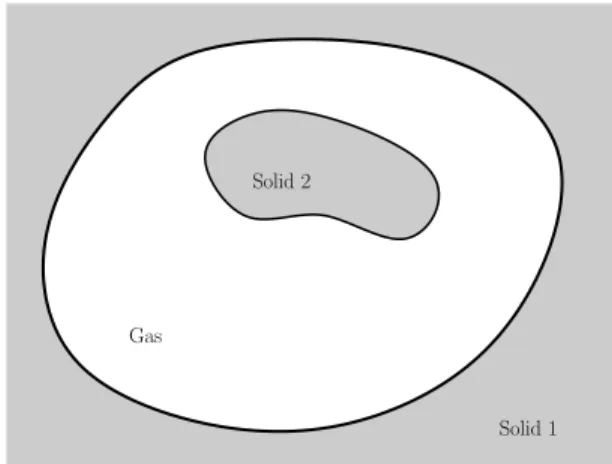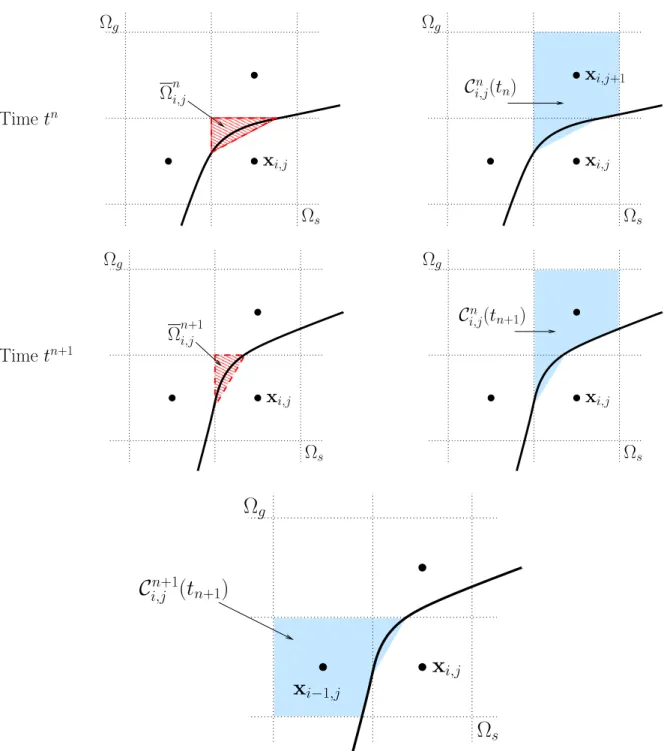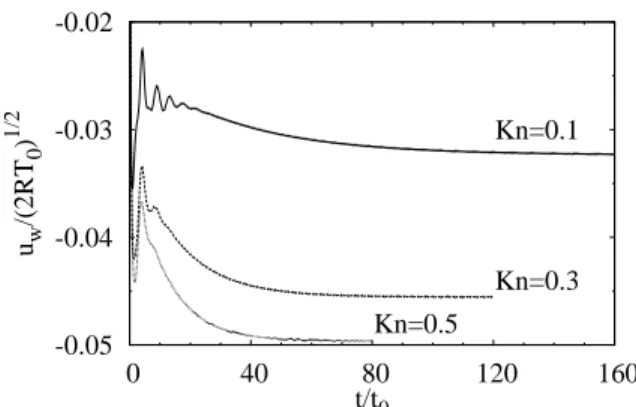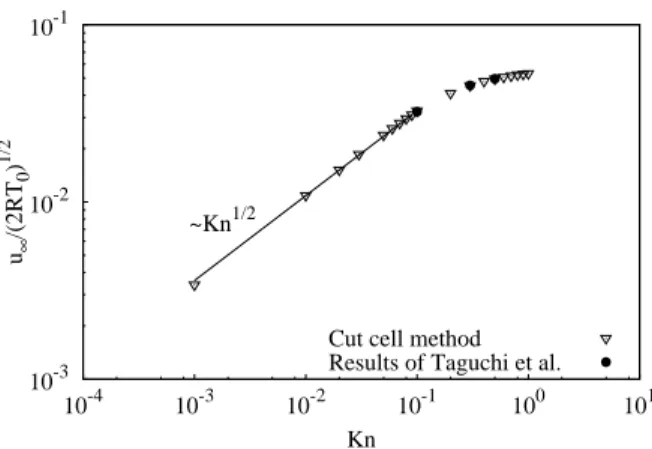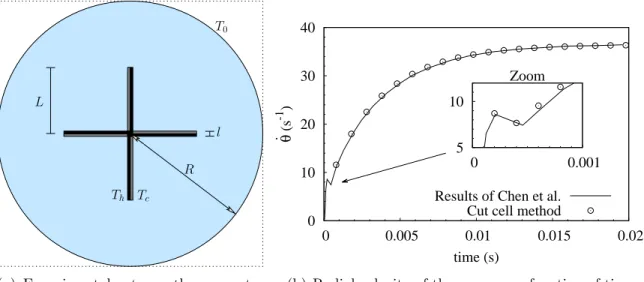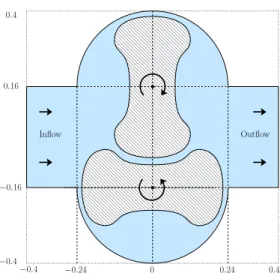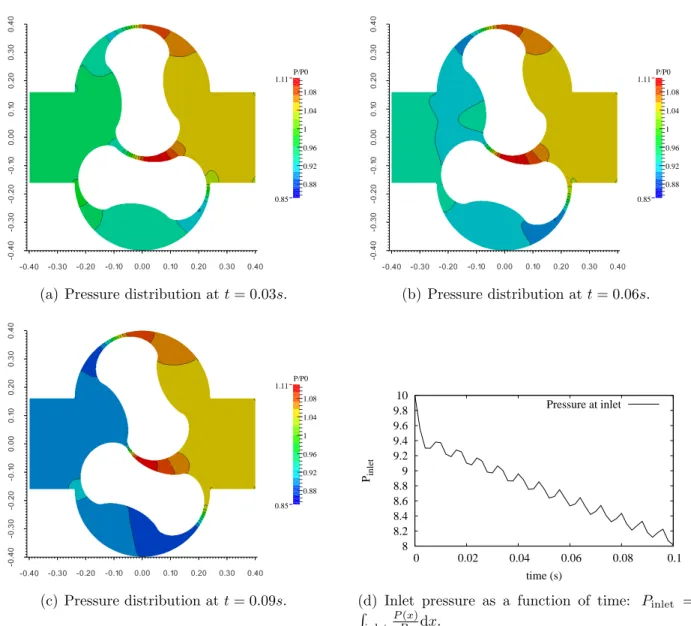HAL Id: hal-01131756
https://hal.archives-ouvertes.fr/hal-01131756
Submitted on 15 Mar 2015
HAL is a multi-disciplinary open access archive for the deposit and dissemination of sci- entific research documents, whether they are pub- lished or not. The documents may come from teaching and research institutions in France or abroad, or from public or private research centers.
L’archive ouverte pluridisciplinaire HAL, est destinée au dépôt et à la diffusion de documents scientifiques de niveau recherche, publiés ou non, émanant des établissements d’enseignement et de recherche français ou étrangers, des laboratoires publics ou privés.
A Cartesian Cut Cell Method for Rarefied Flow Simulations around Moving Obstacles
Guillaume Dechristé, Luc Mieussens
To cite this version:
Guillaume Dechristé, Luc Mieussens. A Cartesian Cut Cell Method for Rarefied Flow Simulations around Moving Obstacles. Journal of Computational Physics, Elsevier, 2016, 314 (1), pp.465-488.
�10.1016/j.jcp.2016.03.024�. �hal-01131756�
A Cartesian Cut Cell Method for Rarefied Flow Simulations around Moving Obstacles
G. Dechrist´e1, L. Mieussens2
1Univ. Bordeaux, IMB, UMR 5251, F-33400 Talence, France.
CNRS, IMB, UMR 5251, F-33400 Talence, France.
(Guillaume.Dechriste@math.u-bordeaux1.fr)
2Univ. Bordeaux, IMB, UMR 5251, F-33400 Talence, France.
CNRS, IMB, UMR 5251, F-33400 Talence, France.
Bordeaux INP, IMB, UMR 5251, F-33400 Talence, France.
INRIA, F-33400 Talence, France.
(Luc.Mieussens@math.u-bordeaux1.fr) Abstract
For accurate simulations of rarefied gas flows around moving obstacles, we propose a cut cell method on Cartesian grids: it allows exact conservation and accurate treatment of boundary conditions. Our approach is designed to treat Cartesian cells and various kind of cut cells by the same algorithm, with no need to identify the specific shape of each cut cell. This makes the implementation quite simple, and allows a direct extension to 3D problems. Such simulations are also made possible by using an adaptive mesh refinement technique and a hybrid parallel implementation. This is illustrated by several test cases, including a 3D unsteady simulation of the Crookes radiometer.
Keywords: kinetic equations, deterministic method, immersed boundaries, cut cell method, rarefied gas dynamics
1 Introduction
In gas dynamic problems, the rarefied regime appears when the mean free path of the molecules of the gas is of the same order of magnitude as a characteristic macroscopic length. The flow has to be modeled by the Boltzmann equation of the kinetic theory of gases. Most of numerical simulations for rarefied flows are made with the stochastic DSMC method [6], especially for aerodynamical flows in re-entry problems. In the past few years, several deterministic solvers have been proposed, that are based on discretizations of the Boltzmann equation or simplified models, like BGK, ES-BGK, or Shakhov models [28].
They are efficient for accurate simulations, multi-scale problems, or transitional flows, for instance.
A recent issue is the account of solid boundary motion in rarefied flow simulations.
This is necessary to simulate flows around moving parts of micro-electromechanical systems
(MEMS) [17, 23], as well as flows inside vacuum pumps. A fascinating illustration of rarefied flows with moving boundaries is the Crookes radiometer, subject of many debates from the late 19th to early 20th century [24]. Recent deterministic simulations help to understand the origin of the radiometric forces [36, 41, 42, 9]. The numerical simulation of the Crookes radiometer is difficult because the motion of the vanes is induced by gas/solid interaction (like thermal creep), which means that an accurate prediction of the flow in the vicinity of the boundary is needed in order to predict the correct velocity of the vanes.
There are several numerical methods for moving boundary problems designed for com- putational fluid dynamics: some of them have recently been extended to deterministic dis- cretizations of kinetic models, and can be divided in two main categories.
First, with body fitted methods, the mesh is adapted at each time step so that the bound- ary of the computational domain always fit with the physical boundary: moving mesh [43]
and ALE methods [18, 19] fall into this category. Despite their extensive use in computa- tional fluid dynamics, very few similar works have been reported in kinetic theory, except by Chen et al. [10]. Methods of the second category are based on Cartesian grid computations and are usually referred to as immersed boundary methods [29]. The mesh does not change during computations, and hence does not fit with the physical boundary. Special treatment is applied on mesh cells that are located close to the boundary in order to take its motion into account. Various extensions of these methods to kinetic theory have been proposed by several authors in [2, 31, 14, 4]. Two recent variants are the inverse Lax-Wendroff immersed boundary method proposed by Filbet and Yang [16] and the Cartesian grid-based unified gas kinetic scheme of Chen and Xu [8]: the boundary motion is not taken into account in these two works, but these methods could in principle be extended to this kind of problem. We also mention the Lagrangian method: while it falls into the first category in CFD, it does not in kinetic theory. Indeed, whatever the motion of the mesh, the distribution function has to be interpolated at the foot of the characteristic for each microscopic velocity. The accuracy of these methods have been shown in [35, 47] for one dimensional problems. Finally, we mention that moving boundary flows can also be treated with DSMC solvers: see, for instance, [30, 33, 39, 40].
In this paper, we try to mix the advantages of body fitted and Cartesian methods: we present a cut cell method for computing rarefied gas flows around moving obstacles. The cut cell method belongs to the Cartesian grid based methods and has been widely used in computational fluid dynamics [22]. However, this is the first extension to moving boundary problems in kinetic theory (complex 3D stationary DSMC simulations have already been investigated in [26, 48]). This approach is well suited to deterministic approximations of the Boltzmann equation and is easy to implement because of the Cartesian structure of the mesh. Moreover, this is, up to our knowledge, the only immersed boundary method to be conservative. The versatility and robustness of the technique is illustrated by various 2D flows, and by the simulation of the unsteady rotation of the vanes of a 3D Crookes radiometer. This article is an extended version of our work announced in [14]. Here, the Boltzmann collision operator is replaced by BGK like models, which is approximated by a discrete velocity method. However, this is not a restriction: other collision operators could
be used, and any velocity approximation (like the spectral method) could be used.
Generally, the problem of cut cell methods is that it is difficult to take into account the various shapes of cells that are cut by the solid boundary: for instance, in 2D, a cut cell can be a triangle, a quadrangle, or a pentagon, and this is worse in 3D. Here, we propose a simple representation of these cells by using the notion of virtual cells that are polygons (or polyedrals) with possibly degenerated edges (or faces). This makes the treatment of any cut cell completely generic: in the implementation, the different kinds of cut cells and the non cut cells are treated by the same algorithm. This makes the extension of the method to 3D problems very easy. However, to make large scale 3D simulations possible, we also use an adaptive mesh refinement (AMR) technique and a special parallel implementation.
The outline of our paper is as follows. In section 2, we give the governing equations of rarefied gas flows and introduce some notations. Our cut cell method is presented in section 3 for 2D problems. It is validated on three different numerical examples in section 4. Then, in section 5, our algorithm is extended to 3D simulations, and a 3D unsteady simulation of the Crookes radiometer is presented. Finally, some conclusions and perspectives are discussed in section 6. Technical details like computations of geometric parameters of the cells are presented in the Appendix.
2 Rarefied gas dynamics
2.1 Boltzmann equation
In rarefied regimes, a monoatomic gas is described by the Boltzmann equation:
∂F
∂t +~v· ∇F =Q(F). (1)
The distribution functionF(t, ~x, ~v) is the mass density of molecules at timetthat are located at the space coordinate~x∈R3 and that have a velocity~v ∈R3. For our approach, it is more relevant to look at the integral form of (1) in a time dependent volumeV(t). The Reynolds transport theorem leads to:
∂
∂t Z
V
FdV + Z
∂V
(~v−w)~ ·~nFdS = Z
V
Q(F) dV, (2)
where∂V(t) is the surface of the volume V(t). Let~xbe a point of this surface: it is moving at a velocity w(t, ~~ x) and the vector ~n(t, ~x) is the outward normal vector to the surface at this point.
The density ρ, momentum ρ~u, total energy E, stress tensor Σ and heat flux ~q, are
computed by the first moments of the distribution function with respect to the velocity:
ρ ρ~u
E
= Z
R3
1 k~vk
1 2k~vk2
F(t, ~x, ~v) dvxdvydvz, Σ =
Z
R3
(~v −~u)⊗(~v−~u)F(t, ~x, ~v) dvxdvydvz,
~ q=
Z
R3
1
2(~v−~u)k~v−~uk2F(t, ~x, ~v) dvxdvydvz,
(3)
where the norm is defined by k~vk2 =v2x+v2y +vz2. The temperatureT of the gas is related to the the energy by the relation E = 12ρk~uk2+32ρRT, whereR is the gas constant defined as the ratio between the Boltzmann constant and the molecular mass of the gas. Moreover, the pressure is computed with the standard equation of state for ideal gases: P =ρRT.
When a gas is at rest, which means in equilibrium state, the molecules are uniformly distributed around the macroscopic velocity and the distribution function is a Gaussian function called Maxwellian:
M[ρ, ~u, T](~v) = ρ
(2πRT)3/2 exp
−k~v−~uk2 2RT
. (4)
The Boltzmann equation implies that the total variation of F comes from the collisions between particles, that are modeled by the Boltzmann operator Q(F). This operator is computationally expensive and several models have been introduced to make its computa- tion easier. Simplest models consists in a relaxation of the distribution function towards a corresponding equilibrium function E:
Q(F) = 1
τ(E −F),
where τ is a relaxation time (see various definitions in section 4). Bhatnagar, Gross and Krook [5] proposed to take E equal to the local equilibrium state, that is
E =M[ρ, ~u, T].
The corresponding BGK model conserves mass, momentum and total energy since the first three moments of the Maxwellian are the same as those of the distribution function. A Chapman-Enskog expansion [7] gives relations between viscosity µ, heat conduction κ and relaxation time. In this case, the expansion yields µ=τ P and κ = 52R τ P. It may be seen that the BGK model necessarily leads to Prandtl number Pr = 52µR/κ equal to 1. However for most of gases, it is physically found to be less than this. More complex functions E such that in Holway [20] and Shakhov [38] models have been developed to obtain the correct Prandtl number. For instance, for the Shakhov model, E reads
E =M[ρ, ~u, T]
1 + (1−Pr)(~v−~u)·~q
k~v−~uk2
RT −5
.
(5P RT)
.
In this article, solid wall interactions are taken into account by the standard fully diffuse reflection. This model states that all particles that collide with a boundary are absorbed by the wall and re emitted with a Maxwellian distribution:
F(t, ~x∈Γ, ~v ∈ Vin) = φM[1, ~uw, Tw], (5) whereTw and~uw are the temperature and the velocity of the boundary Γ at position~x. The coefficient φ is computed in order to set the net mass flux across the wall to zero:
φ =− Z
~v∈Vout
(~v−~uw)·~nwF dvxdvydvz
.Z
~v∈Vin
(~v −~uw)·~nwM[1, ~uw, Tw] dvxdvydvz
. The set of incoming velocities is defined by Vin = {~v such that (~v −~uw)·~nw < 0}, where
~nw is the normal vector to the boundary, pointed to the wall. Similarly, the set of outgoing velocities is Vout = {~v such that (~v −~uw)·~nw > 0}. Note that the boundary condition is defined only for the relative incoming microscopic velocities.
2.2 Reduced model
For plane flows, the computational complexity of the Boltzmann equation can be decreased by the use of a standard reduced distribution technique [11]. This classical method has been extensively used for numerical computations of BGK and Shakhov models. First note that in plane flows, the third component of the macroscopic velocity uz is equal to zero, as well as qz, Σxz, and Σyz. From now on, we define the two dimensional variables
x= (x, y), v= (vx, vy), u= (ux, uy), q= (qx, qy), Σ =
Σxx Σxy Σyx Σyy
. Letf and g be the reduced distribution functions defined by
f(v) = Z
R
F(~v)dvz, g(v) = Z
R
1
2v2zF(~v)dvz.
The macroscopic quantities can be computed from f and g. Indeed, the set of equations (3) readily becomes
ρ ρu
E
= Z
R2
1 v
1 2kvk2
f(v) dvxdvy+ Z
R2
0 0 1
g(v) dvxdvy, Σ =
Z
R2
(v−u)⊗(v−u)f(v) dvxdvy, q=
Z
R2
(v−u) 1
2kv−uk2f(v) +g(v)
dvxdvy,
(6)
where kvk2 = vx2 +vy2. Multiplying by (1,12v2z) the Boltzmann equation (2) and then inte- grating the result with respect to vz gives the following set of equations:
∂
∂t Z
S
fdS+ Z
∂S
(v−w)·nfdl= Z
S
1
τ(f−f) dS,
∂
∂t Z
S
gdS+ Z
∂S
(v−w)·ngdl = Z
S
1
τ(g−g) dS.
(7)
In this case, ∂S(t) is the contour of the surface S(t). Each point x∈ ∂S(t) is moving at a velocity w(t, ~x) and n(t, ~x) is the outward normal vector to the contour at this point. The reduced equilibrium functions are defined by
f=M[ρ,u, T] and g = RT
2 M[ρ,u, T], (8)
for the BGK model and by f=M[ρ,u, T]
1 + (1−Pr)(v−u)·q
kv−uk2
RT −4
.
(5P RT)
, g= RT
2 M[ρ,u, T]
1 + (1−Pr)(v−u)·q
kv−uk2
RT −2
.
(5P RT)
,
(9)
for the Shakhov model, where M[ρ,u, T] is the reduced Maxwellian given by M[ρ,u, T](v) = ρ
2πRT exp
−kv−uk2 2RT
.
To close this section, the boundary conditions (5) are written with the reduced distribution functions as:
f(t,x∈Γ,v∈ Vin) = φM[1,uw, Tw], g(t,x∈Γ,v∈ Vin) =φRT
2 M[1,uw, Tw], (10)
where φ is computed by φ=−
Z
v∈Vout
(v−uw)·nwfdvxdvy
.Z
v∈Vin
(v−uw)·nwM[1,uw, Tw] dvxdvy
. In this formula, uw and Tw are the velocity and temperature of the point x that belongs to the boundary Γ, and nw is the normal vector to the boundary pointed to the wall.
The relative incoming and outgoing velocities at this point are therefore defined by Vin = {v such that (v−uw)·nw <0} and Vout ={vsuch that (v−uw)·nw >0}.
3 The cut-cell method for two dimensional problems
In this section, we present a numerical method to simulate plane flows with moving bound- aries. The governing equations are detailed in section 2.2. The discretization of each variable (velocity, space, and time) is presented in separate sections.
3.1 Discrete velocity approximation
The velocity space is discretized by a Cartesian grid. Let vmin ∈ R2 and vmax ∈ R2 be the lower-left and upper-right corners of this grid. The number of discrete velocities is N2, the velocity step is denoted by (∆vx,∆vy) = (vmax−vmin)/N, and the pth velocity is vp = vmin + (p1∆vx, p2∆vy), such that p = p2N +p1 for all (p1, p2) ∈ [0, N −1]2. The approximation of the distribution function is defined by fp(t,x) = f(t,x,vp). The set of equations (7) is discretized with respect to v by the following set of 2N2 equations:
∂
∂t Z
S
fpdS+ Z
∂S
(vp −w)·nfpdl= Z
S
1
τ(fp−fp) dS,
∂
∂t Z
S
gpdS+ Z
∂S
(vp−w)·ngpdl = Z
S
1
τ(gp−gp) dS.
(11)
The macroscopic quantities are computed with (6), where the integrals overR2 are approx- imated by a sum over the N2 discrete velocity points. They are therefore given by
ρ ρu
E
=
N2−1
X
p=0
1 vp
1 2||vp||2
fp∆vx∆vy +
N2−1
X
p=0
0 0 1
gp∆vx∆vy, Σ =
N2−1
X
p=0
(vp−u)⊗(vp−u)fp∆vx∆vy,
q=
N2−1
X
p=0
(vp−u) 1
2||vp−u||2fp+gp
∆vx∆vy.
(12)
Finally, the equilibrium functions fp and gp are computed either with (8) or with (9).
However, the triplet (ρ,u, T) used in these formulas is obtained with a Newton algorithm that preserves the discrete conservation of Boltzmann equation, rather than with direct computation (12) of the macroscopic quantities. Note that instead of using the algorithm of [27] which is based on entropic variables, we use the algorithm of Titarev [45].
3.2 Space discretization
3.2.1 Cartesian grid and cut cells
Let Ω = [xmin, xmax]×[ymin, ymax] denote the space computational domain. It is discretized by a Cartesian grid of (Nx + 1)× (Ny + 1) points. Their coordinates are computed for all (i, j) ∈ [0, Nx]×[0, Ny] by xi+1
2,j+12 = xmin + (i∆x, j∆y), where (∆x,∆y) = ([xmax− xmin]/Nx,[ymax−ymin]/Ny) and xmin = (xmin, ymin). The computational mesh is therefore made up by Nx×Ny rectangular cells: each cell is denoted by Ωi,j and its center isxi,j.
Since the computational domain is rectangular, physical boundaries do not necessarily fit with the mesh boundary. In order to simulate arbitrary shaped objects, solid and gaseous
domains Ωs(t) and Ωg(t) are introduced. They correspond to the solid and gaseous parts of the computational domain and hence Ω = Ωs(t)∪Ωg(t). We point out that while Ωs and Ωg are time dependent, Ω is not. At time t > 0, a rectangular cell Ωi,j can be in one of these three different states only:
• Ωi,j is a gas cell if it is completely contained in the gaseous domain: Ωi,j∩Ωs(t) =∅.
• Ωi,j is a solid cell if it is completely contained in the solid domain: Ωi,j∩Ωg(t) = ∅.
• Ωi,jis acut cell if it is partially contained in the gaseous domain and partially contained in the solid domain: Ωi,j∩Ωs(t)6=∅ and Ωi,j∩Ωg(t)6=∅.
These three states of cells are shown in figure 1.
3.2.2 Virtual cells
To each cell Ωi,j is now associated a virtual cell Ωi,j(t), which is the section of Ωi,j contained in the gaseous domain: this reads Ωi,j(t) = Ωi,j∩Ωg(t). Whatever the state of the cell (that is to say gas, solid or cut), it is defined with five virtual edges, whose lenghts can be zero.
Four of them, that are denoted by Li±1
2,j(t) and Li,j±1
2(t), fit with the lines of the Cartesian mesh. The last one, denoted by Li,j(t), is a linear approximation of the solid boundary. If the virtual cell has less than five real edges, then at least one length is zero. Finally, we denote by si,j the area of the virtual cell, and|L| will denote the length of any edge L.
At a given time tn=n∆t, all these parameters are denoted as follows:
Ωni,j = Ωi,j(tn), Lni±1
2,j =Li±1
2,j(tn), Lni,j±1 2
=Li,j±1
2(tn), Lni,j =Li,j(tn), sni,j =si,j(tn).
Note that a difficult problem in the cut cell method is that cut cells can take many different shapes (mainly in 3D), which can make the code very complex. A key element of our approach is that all these different shapes are treated generically by using this notion of virtual cell with its 5 virtual edges. Indeed, all the cells are treated in the same way, whatever their state (gas, solid, cut cell) or shape. The different parameters of the three cell states are summarized below, and we refer to figure 2 for three examples of cut cells:
• gas cell: Ωni,j = Ωi,j, |Lni±1
2,j|= ∆y,|Lni,j±1 2
|= ∆x, |Lni,j|= 0, sni,j = ∆x∆y,
• solid cell: Ωni,j =∅,|Lni±1
2,j|= 0, |Lni,j±1 2
|= 0, |Lni,j|= 0, sni,j = 0,
• cut cell: Ωni,j is a part of Ωi,j, and the five lengths of the virtual cell|Lni±1
2,j|, |Lni,j±1 2
|, and |Lni,j| can take any value between 0 and ∆y, ∆x, and p
∆x2+ ∆y2, respectively (see figure 2).
All these parameters are computed with a levelset technique, as explained in appendix A.
3.2.3 Control volumes
The notion of control volume is essential to avoid the use of very small virtual cells that would lead to prohibitively small time steps. The idea is to merge small virtual cells with larger neighboring cells when their areas are smaller than half of the area of a Cartesian cell.
The control volume is constructed by recursion: we look at a given cut cell Ωi,j whose center is inside the solid domain. The corresponding virtual cell Ωni,j necessarily has an area smaller than 12∆x∆y, and it has to be merged with one of its non solid neighboring cells.
This cell is chosen by looking at the largest non solid edge of Ωni,j: the neighboring cell that shares the same edge is chosen for merging (for instance Ωni,j+1 in figure 3, top). If the corresponding neighboring cell has its center inside the gas domain, then the algorithm is stopped and the resulting control volume contains two virtual cells. It happens sometimes that the neighboring virtual cell is also too small (its center is inside the solid domain too): in this case, the same algorithm is used recursively for this virtual cell. This merging procedure ensures that the area of the control volume is always greater that 12∆x∆y.
It is convenient to denote by σni,j the set of indices (i0, j0) such that all the virtual cells Ωi0,j0(t) are merged together. For example, if Ωni,j and Ωni,j+1 merge, then σi,jn ={(i, j),(i, j+ 1)}.
The previous algorithm defines the control volume at timetn. Fort > tn, the virtual cells change (since the solid boundary moves), and the control volume as well. For t between tn and tn+1 the time dependent control volume Ci,jn(t) is defined as follows:
Ci,jn(t) = [
(i0,j0)∈σi,jn
Ωi0,j0(t). (13)
In other words, the set of virtual cells selected at time tn for merging defines the control volume up to tn+1. We point out that if the shape of the virtual cells (and hence of the control volume) can vary in time, the set σi,j is fixed for t∈[tn, tn+1[.
At time tn+1, we have to take into account that there are new virtual cells, some others have disappeared, and the shape of all of them have changed: therefore, a new control volume, denoted by Ci,jn(tn+1), has to be constructed (by the previous recursive algorithm).
We refer to figure 3 for an illustration of this algorithm.
While the previous procedure might look complicated, note that most of the virtual cells do not merge, and hence Ci,jn(t) = Ωi,j(t) for most of them.
The area of the control volumes Ci,jn(tn) andCi,jn(tn+1) are computed easily with sni,j = X
(i0,j0)∈σi,jn
sni0,j0 and sn+1,∗i,j = X
(i0,j0)∈σi,jn
sn+1i0,j0
Note that there is a kind of redundancy with this approach: indeed, in the previous example, since Ωni,j and Ωni,j+1 belong to the same control volume, then the control volumes Ci,jn (t) and Ci,j+1n (t) are the same. However, this makes the implementation much simpler, while the overhead of the computational time is very small: indeed, the number of merged cut cells is very small as compared to the number of gas cells.
3.3 Numerical scheme
From now on, calculations are detailed with the reduced distribution function f. The same analysis can be done with g. The cut cell method is based on a finite volume scheme.
One time iteration (which will be divided into three steps) consists in computing the average valuefn+1i,j,p of the distribution function over the virtual cell Ωn+1i,j from the average valuefni,j,p, defined by
fni,j,p = 1 sni,j
Z
Ωni,j
fp(tn,x) dS. (14) Similarly, fi,j,pn and fi,j,pn+1,∗ stand for the average values of the distribution function over the control volumesCi,jn(tn) and Ci,jn (tn+1). They are defined by
fi,j,pn = 1 sni,j
Z
Ci,jn (tn)
fp(tn,x) dS and fi,j,pn+1,∗ = 1 sn+1,∗i,j
Z
Ci,jn(tn+1)
fp(tn,x) dS. (15) The first step of the method is the computation of fi,j,pn through the average values of f over the virtual cells included in Ci,jn (tn). Definitions (13), (14) and (15) readily lead to
fi,j,pn := 1 sni,j
X
(i0,j0)∈σi,jn
sni0,j0fni0,j0,p. (16)
The second step is the time integration of the integral form of the Boltzmann equation (7) between tn and tn+1: this relation is applied by choosing the surface S(t) as the control volumeCi,jn(t) and by using (15). This gives
sn+1,∗i,j fi,j,pn+1,∗−sni,jfi,j,pn :=
Z tn+1 tn
Ti,j,p(t) +Qi,j,p(t)
dt, (17)
where the transport and collision terms are defined by Ti,j,p(t) = −
Z
∂Cni,j(t)
(vp−w(t))·n(t)fp(t,x) dl, Qi,j,p(t) =
Z
Ci,jn(t)
1
τ(t,x)(fp(t,x)−fp(t,x)) dS.
(18)
The transport integral can be computed as follows. First, definition (13) implies that the integral over∂Ci,jn(t) is the sum of the integrals over the contours of all the virtual cells Ωi0,j0(t) that merge into the control volume Ci,jn (t). Moreover, the velocity w·n is zero for the four edges that fit with the Cartesian mesh lines, while this velocity w isuw for the last edge of
the cell, since it fits with the solid boundary. Finally, the transport integral is written as:
Ti,j,p(t) =− X
(i0,j0)∈σi,jn
Z
∂Ωi0,j0(t)
(vp−w(t))·n(t)fp(t,x) dl
=− X
(i0,j0)∈σi,jn
"
Z
Li0,j0(t)
(vp−uw(t))·n(t)fp(t,x) dl+ Z
L(t)
vp·nw(t)fp(t,x) dl
# , (19) whereL=Li0+12,j0∪Li0+12,j0∪Li0,j0−12 ∪Li0,j0−12 is the union of the four edges that fit with the Cartesian mesh lines. The collision integral of (18) is readily approximated by sτi,j(t)
i,j(t)(fi,j,p(t)−
fi,j,p(t)). The approximation of the time integral in the right-hand side of (17) will be detailed in the following sections.
The third step of the method is the computation of fn+1i,j,p, the average value of f in the new virtual cell Ωn+1i,j . This is done by distributing the valuefi,j,pn+1,∗ given by (17) to the cells Ωn+1i,j merged into the control volume Ci,jn(tn+1):
fn+1i,j,p :=fi,j,pn+1,∗. (20)
A first summary of the cut cell method is given below:
1. The virtual cells Ωi,j(t) merge into some control volumesCi,j(t) and the valuesfi,j,pn are computed with (16).
2. The numerical scheme (17) is applied in order to computed the values fi,j,pn+1,∗. 3. The values fn+1i,j,p are updated with formula (20).
The three steps of the method are illustrated in figure 4 for various situations. Note that because of the merging procedure, there is no issue of appearing/disappearing gas cells: in other words, a small virtual cell necessarily merges with a larger cell before it disappears, and conversely, the average value of f in a new appearing virtual cell is naturally defined through steps 2 and 3. This ensures that the method is conservative, see section 3.4.
It remains to explain how the time integral is approximated in (17) for step 2, which is done in section 3.3.1 and 3.3.2, and to explain how the motion of the solid body is taken into account: this is done in section 3.3.3. The complete scheme is summarized in section 3.3.4 3.3.1 First order explicit scheme
A backward Euler method is applied in order to get a first order approximation of the Boltzmann equation (17). This means that the time integral in (17) is approximated by the
rectangle rule. Using (19) and (18), we find that relation (17) becomes:
fi,j,pn+1,∗ = sni,j
sn+1,∗i,j fi,j,pn − ∆t sn+1,∗i,j
X
(i0,j0)∈σni,j
h Fin0+12,j0,p− Fin0−1
2,j0,p
+
Fin0,j0+12,p− Fin0,j0−1
2,p
+Fi0,j0,p
i
+ sni,j sn+1,∗i,j
∆t
τi,jn (fni,j,p−fi,j,pn ),
(21)
whereFi±1
2,j,p,Fi,j±1
2,p and Fi,j,p are the numerical fluxes across the five edges of the virtual cell that are computed with a standard upwind scheme:
Fi+n 1
2,j,p:=|Lni+1
2,j| min(vp1,0)fi+1,j,pn + max(vp1,0)fi,j,pn , Fi,j+n 1
2,p :=|Lni,j+1 2
|
min(vp2,0)fi,j+1,pn + max(vp2,0)fi,j,pn , Fi,j,pn :=|Lni,j|
min([vp −uw(tn,rni,j)]·nw(tn,rni,j),0)fw(tn,rni,j,vp) + max([vp−uw(tn,rni,j)]·nw(tn,rni,j),0)fi,j,pn
,
(22)
where rni,j is the center of Lni,j. It is recalled that vp1 and vp2 are the coordinates of the pth microscopic velocity, i.e. vp = (vp1, vp2). Moreover,nw(tn,rni,j) is the outward normal to the edgeLni,j, that fit with the physical boundary. The computation of the velocity uw(tn,rni,j) of the boundary is detailed in section 3.3.3. Finally the discrete boundary condition is similar to its continuous form (10), that is to say:
fw(tn,rni,j ∈Γ,vp ∈ Vin) =φM[1,uw(tn,rni,j), Tw], gw(tn,rni,j ∈Γ,vp ∈ Vin) = φRT
2 M[1,uw(tn,rni,j), Tw], (23) where φ is given by
φ =−
P
vp∈Vout(vp−uw(tn,rni,j))·nw(tn,rni,j)fi,j,pn ∆vx∆vy P
vp∈Vin(vp−uw(tn,rni,j))·nw(tn,rni,j)M[1,uw(tn,rni,j), Tw]∆vx∆vy.
Note that the boundary condition is defined only for the velocities vp ∈ Vin = {v|(v− uw)·nw <0}, which is compatible with the definition of the numerical boundary fluxFi,j,pn (see (22)).
3.3.2 First order semi-implicit scheme
When the Knudsen number is very small, the previous scheme (21), which is explicit, is too expensive: the CFL condition induces a time step which is of the order of the relaxation time. It is now standard in kinetic theory to use instead an implicit/explicit scheme (see for instance [32] for the BGK equation and [15] for other methods). The idea is to use an
implicit scheme for the stiff collision part, while the transport part is still approximated by an explicit scheme. This kind of scheme can be easily extended to the cut cell method. For instance, the simplest first order semi-implicit scheme is
fi,j,pn+1,∗ = sni,j
sn+1,∗i,j fi,j,pn − ∆t sn+1,∗i,j
X
(i0,j0)∈σni,j
h Fin0+12,j0,p− Fin0−12,j0,p
+
Fin0,j0+12,p− Fin0,j0−12,p
+Fi0,j0,pi + ∆t
τi,jn (fn+1,∗i,j,p −fi,j,pn+1,∗),
(24)
where the numerical fluxes are still computed with (22). The equilibrium function fn+1,∗i,j,p
depends on the macroscopic quantities that have to be computed before fi,j,pn+1,∗: this can be done by summing (24) over the discrete velocities, so that the collision term vanishes, which gives an explicit relation for these macroscopic quantities.
3.3.3 Motion of the solid body
The motion of the solid body is taken into account in the scheme by the variation of the area of the control volume (from sni,j to sn+1,∗i,j ) and by the velocity uw(tn,rni,j) of the solid boundary, see (21) and (22). These quantities are computed as follows.
Letc(t) and θ(t) be the coordinates of the center of mass and the inclination of the solid body. Its translational and rotational velocities are then denoted by ˙c(t) and ˙θ(t). The motion of the solid body, with massm and moment of inertiaJ, is modeled by the Newton’s laws of motion that are discretized as follows:
cn+1 =cn+ ∆tc˙n and θn+1 =θn+ ∆tθ˙n, (25)
˙
cn+1 = ˙cn+ ∆tFn/m and θ˙n+1 = ˙θn+ ∆t Tn/J, (26) where Fand T are the force and torque exerted by the gas on the solid body. They can be computed by using the stress tensor Σw at the boundary with the formula
F= Z
∂Ωg
Σwnwdl and T = Z
∂Ωg
(x−c)×(Σwnw)dl.
These relations can be approximated by any quadrature formula, and we find it convenient to use a summation over all the cells of the computational domain to avoid too many tests.
This yields:
Fn =
Nx
X
i=1 Ny
X
j=1
Σw(tn,rni,j)nw(tn,rni,j)|Lni,j|, (27)
Tn =
Nx
X
i=1 Ny
X
j=1
(rni,j−cn)×(Σw(tn,rni,j)nw(tn,rni,j))
|Lni,j|, (28)
Since |Lni,j| is non-zero only for solid edges of cut cells, these formula are consistent approx- imations of the previous definition.
Moreover, while the stress tensor is defined by (12), the boundary condition has to be taken into account to define the distribution of incoming velocities, and we set
Σw(tn,rni,j) = X
vp∈Vin
(vp−uw(tn,rni,j))⊗(vp−uw(tn,rni,j))fw(tn,rni,j,vp) ∆vx∆vy
+ X
vp∈Vout
(vp−uw(tn,rni,j))⊗(vp−uw(tn,rni,j))fi,j,pn ∆vx∆vy.
(29)
The boundary condition fw(tn,rni,j,vp) is defined by (23). The new velocity of the wall is finally computed with
uw(tn+1,rn+1i,j ) = ˙cn+1+ (rn+1i,j −cn+1)⊥θ˙n+1, (30) wherea⊥ is the vector obtained after a rotation of 90 degrees of any vector ain the counter- clockwise sense.
3.3.4 Summary of the numerical scheme
For the convenience of the reader, the different steps of the complete numerical scheme are summarized below.
We assume that, at time tn, all the following quantities are known: the average value of the distribution function fni,j,p in each virtual cell Ωni,j, the parameters of position (cn,θn) and velocity ( ˙cn, ˙θn) of the solid body, and hence the wall velocity uw(tn,rni,j). One time iteration of the numerical scheme is decomposed into the following 7 steps:
1. The position of the solid body at tn+1 is computed with (25).
2. The virtual cells are arranged into control volumes Ci,jn(tn) following the rule given in section 3.2.3. The distribution function is averaged over the control volumes Ci,jn (tn), see (15).
3. The virtual cells and control volumes are moved according to the new position com- puted at step 1. The areas sni,j and sn+1,∗i,j are computed by using a level set method (see appendix A for more details).
4. The value of the distribution at each solid boundaries is computed through boundary condition (23).
5. The stress tensor Σw at each solid boundaries is computed with (29), which gives force Fn and torqueTn with (27) and (28). Then the translational and rotational velocities are computed at time tn+1 by the discrete Newton laws (26), and finally the new wall velocity is computed with (30).
6. Scheme (21) is used to pass from fi,j,pn (the average value of f at time tn in the control volume Ci,jn(tn)) to fi,j,pn+1,∗ (the average value of f at time tn+1 in the control volume Ci,jn (tn+1)).
7. The values fn+1i,j,p of f at time tn+1 in each virtual cell that are merged into the control volumeCi,jn(tn+1) are updated with (20).
3.4 Properties of the scheme
3.4.1 Positivity
Standard arguments show that the explicit scheme (21) preserves the positivity of the solution if ∆t satisfies the following CFL condition:
∆t
maxi,j
1 τi,jn
+ max
i,j,p
φni,j,p sni,j
≤1, (31)
where
φi,j,p = X
(i0,j0)∈σni,j
|Li0+12,j0|v+p1 − |Li0−12,j0|vp−1 +|Li0,j0+12|v+p2 − |Li0,j0−12|v−p2 +|Li0,j0|((vp−uw(tn,rni,j))·nw(tn,rni,j))+
(32)
and v+ = max(v,0), v− = min(v,0). For a correct description of the flow, it is necessary that the discrete velocity grid contains the solid velocity uw at any time (since the diffuse boundary condition produces particles with uw as mean velocity). Under this assumption, it can be proved that φi,j,p ≤ C(vx,max/∆x+vy,max/∆y), where C = 1/2. This gives a simpler CFL condition, and in practice, it is relaxed by takingC = 0.9 without any stability problems
For the semi-implicit scheme (24), a similar condition can be found, which is independent of τi,jn.
3.4.2 Conservation
Since our scheme is a finite volume method in which a conservative reflexion boundary condition is applied to compute the numerical fluxes at each solid edge, it is naturally conservative. This is proved below for the explicit scheme (21).
Let Mn be the total mass of gas in the gas domain Ωg at time tn. It is convenient to write the total mass at time tn+1 as
Mn+1 =
Nx,Ny
X
i,j=1
δi,jn sn+1,∗i,j
N2−1
X
p=0
fi,j,pn+1,∗∆vx∆vy, (33)
where δni,j = 1 if xi,j ∈Ωg and 0 else: this function allows to take into account merged cells of a same control volume only once. Indeed, there is only one couple of indices (i0, j0) in σni,j for which xi0,j0 is inside the gas domain.
Then fi,j,pn+1,∗ is replaced by its value given by (21) and we get Mn+1 =Mn+
Nx,Ny
X
i,j=1 N2−1
X
p=0
∆tFi,j,kn ∆vx∆vy.
Indeed, opposite fluxes across same Cartesian edges cancel out, the velocity sum of the collision operator is zero, and there remains only the numerical fluxes Fi,j,kn across the solid edge of cut cells. By using the boundary condition, the velocity sum of such fluxes gives
N2−1
X
p=0
Fi,j,pn ∆vx∆vy = X
vp∈Vin
(vp−uw(tn,rni,j))·nw(tn,rni,j)fw(tn,rni,j,vp)|Lni,j|∆vx∆vy
+ X
vp∈Vout
(vp−uw(tn,rni,j))·nw(tn,rni,j)fi,j,pn |Lni,j|∆vx∆vy
= 0.
This shows that Mn+1 =Mn and concludes the proof.
Finally, note that it is standard from the positivity and conservation properties to con- clude that the scheme if L1 stable.
4 Numerical results
4.1 Translational motion under radiometric effect
An infinite set of thin plates of height D is located in an infinite channel of width 4D. The distance between two plate centers is 4D. This experiment has been numerically investigated in [42], where the plates are infinitely thin (their thickness is zero). The temperature of the right side of a plate is twice as the temperature of its left side. This induces a force that can be interpreted as the difference between the radiometric force and gas friction, and make the plates move. We point out that all the plates move at the same velocity. After a while, the radiometric force is balanced with gas friction and the total force decreases to zero. At this time, the plates have reached their stationary velocity. In [42] the ES-BGK model is used and simulations are made in a moving reference frame in which the channel velocity is positive while the plates are motionless. The total force applied on the plates is zero for a specific channel velocity which corresponds to the stationary velocity of the plates. In our work, the BGK model is used to described the behavior of the gas and plates are D/10 thick (see Fig. 5(a)). The transient motion of the plates (i.e. plates velocity before the stationary state is reached) can be simulated with the cut cell method in a fixed frame of reference. In that case, the motion depends on the mass of a plate. If we denote by ρ0 the
initial density of the gas, this mass is set to m = ρ0D2/2. The computational domain is a rectangle of size 4D×2D that describes the upper part of the channel (Fig. 5(a)). The left and right boundary conditions are periodic so as to simulate the infinite channel. The bottom of the computational domain fits with the center of the channel: specular-reflection boundary condition is applied to take into account the symmetry. At last, the top of the domain corresponds to the wall of the channel, the standard diffuse boundary condition is used. During a whole simulation, there is always one and only one plate in the computational domain: when a plate goes out, an other one comes in. Note that solid and cut cells only appear near this plate. To take its temperature into account, the boundary of the plate is modeled with the diffuse-reflection condition. Finally, the relaxation time and Knudsen number are defined by the relations:
τ = µ
ρRT0 and Kn = 2
√π
√2RT0 ρ0RT0/µ
. D,
where µis the viscosity of the gas and T0 the initial temperature of the gas.
Our simulations have been done for a wide range of Knudsen numbers from 10−3 to 1.
Converged results are obtained for a velocity grid that contains from 202 to 402 points (this depends on the Knudsen number) and for a spatial mesh made up of 400×200 cells, which means that a plate encloses 10 cells. For coarser grids, the number of cells enclosed in the plate is too small to capture the shape of its edges with enough accuracy. As expected, the magnitude of the velocity of the plates increases until they reach their final velocity, as illustrated for three different Knudsen number on figure 5(b).
The variation of the stationary velocity of the plates is plotted as function of Kn on figure 6. For small Knudsen numbers, the final velocity seems to be proportional to √
Kn while this velocity tends to a constant for high Knudsen number. These simulations show a good agreement between our results and the results obtained in [42].
4.2 The Crookes radiometer
The Crookes radiometer was invented by Crookes in 1874 [12]: it is a glass globe containing four vanes immersed in a low pressure gas. Each vane has one black side and one shiny side, and when the globe is exposed to light, the vanes rotate. This was first understood as a rarefied gas dynamics effect by Reynolds [34], but there are still discussions on the order of magnitudes of the forces involved in this device. We refer to the recent review of Ketsdever et al. [24] for historical details. Recently, numerical simulations improved the understanding of the radiometric effect, like in [41, 42, 37].
The dynamical acceleration process of the vanes has been recently studied in [9]: it uses the unified gas-kinetic scheme combined with a moving mesh approach [10] to simulate the motion of the vanes. In this case, the moving mesh approach is very convenient because the initial mesh just rotates without distortions. In this section, we show that the same results as [9] can be obtained with our cut cell method.
